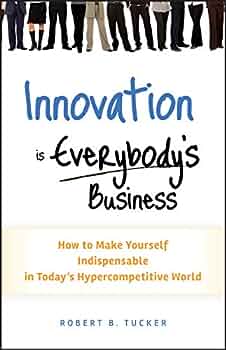I became interested in the book Innovation is Everybody’s Business because it takes a different tact than most do on the subject. Instead of focusing on what the company, organization, or leadership can do to spur innovation, it focuses on what you, the employee, can do, intentionally and proactively; and as part of the normal course of your job.
Tucker defines innovation as “the act of coming up with ideas and successfully bringing them to life to solve problems and create opportunities.” And he views innovation as a mindset and how you approach your work, not something you must do after you get your “regular work” done.
Starting at a high level, Tucker lists his four I-Skill Principles:
- Innovation isn’t something you do after you get your work done. It’s how you do your work.
- Innovation is about more than inventing new products. It’s about figuring out how to add value where you are.
- You can innovate in any job, any department, or any organization.
- Innovation is about taking action.
Having identified these “opportunity mindset” I-Skill Principles, the author also takes a less-than-positive stance by opining that there exist only a few truly innovative companies. He writes “There are no flawlessly innovative companies. There are only those that are somewhat less dysfunctional and bureaucratic than others and that somehow manage to deliver growth and breakthrough innovations to the market despite themselves.”
The remainder of this book is primarily devoted to Tucker’s Seven Fundamental I-Skills, as follows:
Embrace the Opportunity Mindset. Seven ways to activate your opportunity mindset:
- Learn to consciously shift your perspective
- Think small
- Listen for “there’s got to be a better way” mutterings
- Pay attention to happy accidents
- Look for problems customers have that aren’t being solved
- Look for opportunities to eliminate non-value-adding work
- Think big
Become an Assumption Assaulter. Four strategies for improving the quality of your thinking:
- Question the value of experience
- Look for your opening
- Cultivate a questioning mindset
- Take time to think about how you think
Cultivate a Passion of the End Customer. Five ways to focus on your internal and external customers:
- Understand the business you’re in
- Develop empathy for the customer
- Strive for a big picture perspective
- Take on the customer’s problem
- Treat your boss like a customer
Think Ahead of the Curve. Eight components to thinking ahead of the curve:
- Audit your information diet
- Think of yourself as the eyes and ears of your organization
- Build your information and support networks
- Seek out forward-thinking, idea-oriented people
- Master the art of the deep-dive
- Develop your point of view on key issues
- Connect the dots
- Give people permission to give you bad news
Become an Idea Factory. Ten ways to keep your idea factory humming:
- Inspect your idea factory regularly
- Identify when and where you do your best thinking
- Enhance your creative environment
- Know when to multitask and when to unitask
- Think of creativity as something you practice, not something you’re born with
- Use your innovation style to your advantage
- Expand your own methods for getting “unstuck”
- Make the most out of recreation
- Remember to take your “Doug Day”
- Devise a method for downloading your ideas
Become a Standout Collaborator. Twelve ways to become a standout collaborator:
- Seek to be invited to participate on special project teams
- Identify what good collaboration looks like
- Know what bad collaboration feels like
- Unleash your inner collaborator
- Become an energizer and not an energy drain
- Lead collaboratively
- Figure out the right size for your team
- Give thought to team composition
- Invite people to join you
- Recruit people who have a track record of results
- Launch your project team right
- Establish a group process
Build the Buy-In for New Ideas. Eight ways to build the buy-in for new ideas:
- Do your homework
- Let others think it was their idea
- Customize your communication style
- Make it safe for buyers to say yes
- Focus on benefits and overcoming resistance
- Use the power of stories
- Cross boundaries to build support for your idea
- Be persistent
Challenge: If you’re interested in learning your Innovation Quotient (IQ), according to the author, reach out to me and I’ll send you his 16 questions and instructions for scoring yourself.
I hope this summary sparks your interest to further explore innovation, this book and its concepts.

